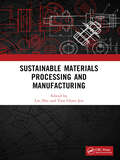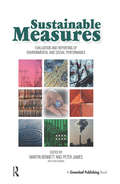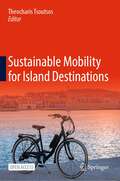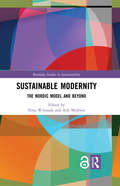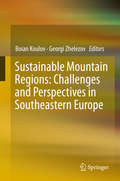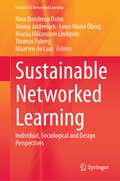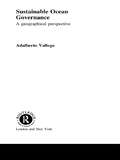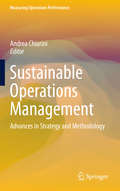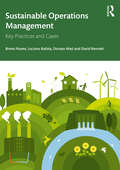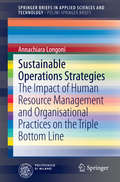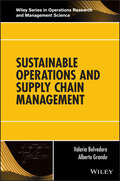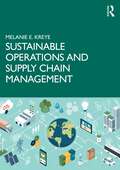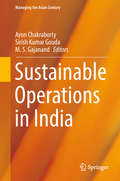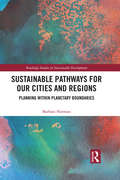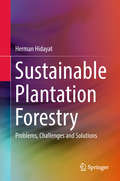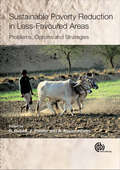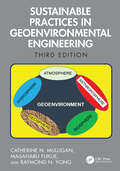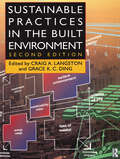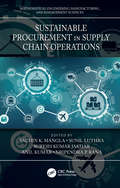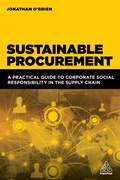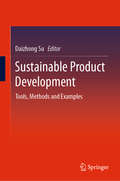- Table View
- List View
Sustainable Materials Processing and Manufacturing: Proceedings of the 3rd International Conference on Sustainable Materials Processing and Manufacturing
by Tien-Chien Jen Lin ZhuThe conference on ‘Substantial Materials Processing and Manufacturing (SMPM)’ aims to bring together scientists, researchers, and companies to attend and share their vision, ideas, recent developments as well as advanced scientific and technical knowledge in the field of materials processing and manufacturing. The conference is concerned with sustainable engineering, life cycle engineering, sustainable manufacturing systems and technologies, sustainable materials and processing, sustainable product design and development, sustainable supply chain and business models, renewable energy and sustainable development, Industry 4.0 and Internet of Things, modelling and simulation of sustainable manufacturing, intelligent agricultural equipment, etc. The conference has invited some academicians and research leaders in related fields to give the keynote report. Based on the theme of this book, eighteen outstanding and high-quality manuscripts have been selected for the publication in this book. The detailed information is presented below.
Sustainable Measures: Evaluation and Reporting of Environmental and Social Performance
by Peter James Martin Bennett Leon KlinkersEnvironmental and social performance measurement and reporting by business has become a high-profile issue during the 1990s. It is increasingly being requested by stakeholders and required by governments. Companies too are finding that they need better environmental and social performance data for effective internal management. And there are a growing number of standardisation initiatives – such as the ISO 14031 guidelines on environmental performance evaluation or the CERES Global Reporting Initiative (GRI) template for sustainability reporting – that are aimed at making it easier for more companies to take action, and for stakeholders to compare their progress.Sustainable Measures collects together most of the key work and individuals concerned with the topic from around the world. Contributions include: environmental and social reporting by John Elkington and colleagues at SustainAbility; the GRI discussion draft; Roger Adams and Martin Houldin on the FEE study of environmental reporting; Janet Ranganathan of the World Resources Institute on sustainability measures; and Martin Bennett and Peter James on ISO 14031 and the future of environmental performance evaluation. There are also chapters examining current practice in Austria, Denmark, India, Indonesia, Japan, the Netherlands and South Africa, developments in electronic reporting, as well as case studies of Baxter, Kunert, Niagara Mohawk, Unox, The Body Shop and the UK water industry, and an analysis of leading social reports.The book is essential reading for all academics, campaigners, policy-makers and practitioners with an interest in issues such as:The standardization and comparability of environmental and social performance measuresMeasuring and reporting on sustainable businessEco-points and other means of evaluating product impactsThe implementation of measurement and reportingBest practice in corporate environmental and social reportingNew means of communicating environmental dataEnvironmental performance evaluation in developing countries
Sustainable Mobility for Island Destinations
by Theocharis TsoutsosThis open access book presents the findings of the CIVITAS DESTINATIONS project regarding the link between mobility and tourism in urban areas and the complications tourist destinations face in becoming more sustainable. It integrates the tourist mobility needs and the associated fluctuation impacts in the design of mobility solutions in order to enforce the accessibility, attractiveness, efficiency and sustainability of transport services and infrastructure for both residents and tourists in island cities such as Rethymno, Crete, and Valetta, Malta. Sustainable Mobility for Island Destinations contains contributions from highly experienced academics, engineers, and planners in the area of sustainable tourism, mobility services, and smart solutions design companies assisting: the change of the mind set in insular and tourism areas; the adoption of green mobility systems and services; andmonitoring the environmental benefits to assist towards the Climate Change. It explores the challenges tourist islands face, such as the seasonal fluxes in transport usage, the pressures of tourism to provide aesthetic green spaces, and the space issues of being an island in relation to economic potential and infrastructure construction. The book suggests areas for future research, and implementation of innovative systems and policies. It will be of interest to academics, planners, decision makers, and environmentalists.
Sustainable Mobility in a Fast-Changing World: From Concept to Action (Sustainable Development Goals Series)
by Nancy Vandycke José M. ViegasOur world is changing fast. Countries’ transport systems, which have long been shaped by project-by-project considerations, must help achieve higher-level goals for the well-being of mankind, as embodied by the UN's Sustainable Development Goals and the Paris Climate Agreement. New forces impose greater effectiveness in the way public choices are made, such as making better use of data and technologies, adopting a more inclusive and participatory approach to decision making, and addressing social concerns about equity. Transport practitioners and country decision-makers have been looking for structured and coherent guidance about ways to adjust to these new dynamics and change the trajectory of transport system. This book examines the rationale for and details an innovative approach for public decision-making to expedite the pace to sustainable mobility.
Sustainable Modernity: The Nordic Model and Beyond (Routledge Studies in Sustainability)
by Nina Witoszek Atle MidttunThe Open Access version of this book, available at https://www.taylorfrancis.com/books/e/9781351765633, has been made available under a Creative Commons Attribution-Non Commercial-No Derivatives 4.0 license. In the 21st century, Norway, Denmark and Sweden remain the icons of fair societies, with high economic productivity and quality of life. But they are also an enigma in a cultural-evolutionary sense: though by no means following the same socio-economic formula, they are all cases of a "non-hubristic", socially sustainable modernity that puzzles outside observers. Using Nordic welfare states as its laboratory, Sustainable Modernity combines evolutionary and socio-cultural perspectives to illuminate the mainsprings of what the authors call the "well-being society". The main contention is that the Nordic uniqueness is not merely the outcome of one particular set of historical institutional or political arrangements, or sheer historical luck; rather, the high welfare creation inherent in the Nordic model has been predicated on a long and durable tradition of social cooperation, which has interacted with global competitive forces. Hence the socially sustainable Nordic modernity should be approached as an integrated and tightly orchestrated ecosystem based on a complex interplay of cooperative and competitive strategies within and across several domains: normative-cultural, socio-political and redistributive. The key question is: Can the Nordic countries uphold the balance of competition and cooperation and reproduce their resilience in the age of globalization, cultural collisions, the digital economy, the fragmentation of the work/life division, and often intrusive EU regulation? With contributors providing insights from the humanities, the social sciences and evolutionary science, this book will be of great interest to students and scholars of political science, sociology, history, institutional economics, Nordic studies and human evolution studies.
Sustainable Mountain Regions: Challenges and Perspectives in Southeastern Europe
by Boian Koulov Georgi ZhelezovCentral to this edited volume is the proposition that the mountainous border region of Southeastern Europe needs to become a special target of European Union scale, regional development policy-making. Vivid case studies from eleven Central and Southeast European states present diverse perspectives on this region's physical geography, economy and demographics and demonstrate the integrative potential of the geographic perspective in mountain research. Europe as a whole has a lot to gain from a "sustainable mountains" policy, especially in Southeast Europe. In their focus on the sustainable development of such areas, the chapters consider regional development policy, ecosystem services assessment, small-scale tourism, and forestry management. This book will be of interest to a wide audience, including academics, students, and practitioners in the fields of geography, ecology, and environmental studies.
Sustainable Networked Learning: Individual, Sociological and Design Perspectives (Research in Networked Learning)
by Thomas Ryberg Maarten De Laat Nina Bonderup Dohn Jimmy Jaldemark Lena-Maria Öberg Marcia Håkansson LindqvistThis book provides cutting-edge research on networked learning, focusing on issues of sustainability in design for learning, data use, and networked learning connections. It contributes novel theoretical perspectives on networked learning, its role in society and potential for sustainable learning design. It further contributes a set of exemplary empirical cases - exemplary in terms of their innovative learning designs, pedagogical use of technology in connecting learners, and/or critical reflections on implications of utilizing different technologies to support learning. The book is organized into four main sections: 1) Data and datafication, 2) Sustainable learning design, 3) Sociological perspectives on Networked Learning, and 4) Networked learning in times of lockdown. Concluding the book is a final chapter which points to emerging issues within the field of networked learning, based on discussion of perspectives from the chapters The book's focus on the nature of learning and technology-mediated interactions makes it of prime significance to researchers and practitioners in the field of technology-supported teaching and learning.
Sustainable Ocean Governance: A Geographical Perspective (Routledge Advances in Maritime Research)
by Adalberto VallegaThis topical book examines ocean governance and calls for close co-operation between science and policy. Adalberto Vallega uniquely considers the ocean as a spatial complex system which must be represented as a whole and argues that scientific approaches must change to achieve progress and co-operation between science and policy.
Sustainable Oil and Gas Using Blockchain (Lecture Notes in Energy #98)
by Si Chen Soheil SarajiThis monograph explores the potential of blockchain technology to facilitate the transition in the oil and gas (O&G) industry.As the world shifts towards a sustainable energy future, the oil and gas industry faces significant challenges and opportunities. Focusing on the development of a sustainable O&G industry, the book delves into the role of climate and financial markets in the energy sector, applications of blockchain in sustainable energy development, and the challenges of legal and regulatory issues in applying blockchain technology. It provides insight into how the energy industry is already working on reducing carbon emissions and paving the way to a sustainable future with detailed examples of reducing methane emissions, carbon credit markets, sustainable aviation fuels, and plastics. The book also examines how O&G companies could further their sustainability initiatives using blockchain technology for emission data monitoring, carbon capture, utilization, storage, and supply-chain management to develop clean products.
Sustainable Operations Management
by Andrea ChiariniThis book presents innovative research on various aspects of sustainability in the field of operations management and illustrates the potential of sustainability thinking and practice to improve operations performance and thereby meet customer needs. Particular attention is devoted to corporate social responsibility and marketing strategy, knowledge management for sustainability, the role of culture in a sustainable built environment, sustainable manufacturing through the application of lean and green concepts, advancing sustainability through ISO standards, and the sustainable supply chain. The present decade is proving to be a time of change in terms of business strategies and operations management. Many of the trends are still subject to uncertainty, but an understanding of the need for, and benefits of, sustainability can give a clear indication of their trajectory. Consumers and markets in general believe that while implementing their business strategies, companies should also try to improve society and the environment and to exercise social responsibility toward their employees. This book provides insights into how this may be achieved, and it is recommended for researchers as well as all practitioners and managers dedicated to enhancing sustainability in operations.
Sustainable Operations Management: Key Practices and Cases
by David Bennett Breno Nunes Luciano Batista Donato MasiSustainable Operations Management applies the issues of sustainability to all strategic decisions of operations: capacity management, supply network, process technology, and development and organisation. This book extends the existing literature of operations management that for years has been paramount in creating economic value with little consideration of environment and social dimensions. Whilst based on robust theoretical frameworks, some developed by its own authors, the book is enriched by international case studies and real-world illustrations throughout, to demonstrate how this theory translates to practice. Each chapter begins with learning objectives and ends with a summary, activity, and questions for discussion. Readers will gain a comprehensive and in-depth knowledge on how to manage operations for sustainability. They will learn the ways to formulate a sustainable operations strategy and the elements involved in managing tactical and operational activities to enhance sustainability performance over time. The book covers all aspects of the new business sustainability paradigm from an operations perspective, including sustainable development goals, the circular economy and digital transformation. With international agreements and national policies in place around themes such as climate change, ocean plastic pollution, loss of biodiversity, water scarcity, and zero landfill targets, this book will be a must for any university abiding to the Principles of Responsible Management Education (PRIME). The text is suitable mostly for MSc and MBA students on sustainable supply chain and operations management modules as well as broader Operations Management courses, but it can also be used for final-year Undergraduate students as part of advanced operations management modules. Online resources include chapter-by-chapter PowerPoint slides and a test bank of questions.
Sustainable Operations Strategies
by Annachiara LongoniThis book provides detailed guidance on how sustainability, in terms of the triple bottom line, can be developed in operations strategies via human resource management (HRM) and organizational practices such as teamwork, training and employee involvement. The impacts of HRM and organizational practices on environmental and social sustainability, trade-off optimization and the triple bottom line are carefully analyzed, with attention to aspects including organizational responsibility and worker commitment to sustainability. Valuable tips are offered on formulation and implementation of sustainable operations strategies and in addition the alignment of lean manufacturing and the triple bottom line is addressed in a dedicated section. The background to the book and the reason for its topicality, is the difficulty that companies are experiencing in defining and implementing effective sustainability programs that enhance environmental, social and economic sustainability and optimize possible trade-offs. Moreover, although the operations management literature has focused mainly on technical aspects, HRM and organizational practices may also be relevant in enhancing programs' effectiveness and directly impacting sustainability.
Sustainable Operations and Supply Chain Management
by Alberto Grando Valeria BelvedereSustainable Operations and Supply Chain Management addresses the most relevant topics of operations and supply chain management from the perspective of sustainability. The main focus is to provide a step by step guide for managerial decisions made along the product life-cycle, following a path made up of the following steps: product design, sourcing, manufacturing, packaging and physical distribution, reverses logistics and recovery.
Sustainable Operations and Supply Chain Management
by Melanie E. KreyeThis book takes as its starting point the need to improve sustainability performance across the triple bottom line and reach global sustainable development goals. As such, it places sustainability at the heart of developing and explaining relevant theory, concepts and models in operations and supply chain management. Whereas previous textbooks on operations and supply chain management have focused on augmenting existing models of operations and supply chain management by simply adding on selected sustainability issues, this textbook places sustainability at the heart of operations and supply chain management. Sustainable Operations and Supply Chain Management consolidates the tools, concepts and methods of operations and supply chain management relevant for reaching sustainable development goals. This book includes not only descriptions of the theories and models but also practical cases based on the most recent developments in different industry sectors, including user electronics, healthcare, fashion and energy. Relevant student exercises are also included for use in the classroom or in personal study. This book provides an ideal introduction for Bachelor or Masters-level students, whether they are on general management and business degrees, or are focused on areas such as engineering management, technology management or sustainability management. Furthermore, university-level teachers and lecturers will find the material presented in this book a valuable basis for structuring their courses on operations and supply chain management in the context of sustainability.
Sustainable Operations in India (Managing The Asian Century Ser.)
by Ayon Chakraborty Sirish Kumar Gouda M. S. GajanandThis book focuses on understanding the status quo of sustainable practices in industry operations from an emerging economy perspective, presenting various practices in India. In order to offer a balance between theory and practice, it provides guidelines for applying models to achieve the goal of sustainability in this competitive environment. The chapters include theoretical perspectives, models and empirical evidence on sustainable practices from Indian industries. The book also presents a scholarly perspective on sustainable operations from various researchers and practitioners in India for a global audience in academia and industry.
Sustainable Pathways for our Cities and Regions: Planning within Planetary Boundaries (Routledge Studies in Sustainable Development)
by Barbara NormanIn an urbanizing world, the majority of people live in urban settlements predominantly on the coastal edge. Focus has historically been on people, place and the challenges and opportunities of living with global change, and academic attention has largely been on sustainability science or sustainable solutions. This book seeks to strengthen the relatively weak link between sustainability science, land use planning and socio-economic change, and show that a more integrated approach to planning will be required to develop more sustainable pathways for cities and regions in the future. Sustainable Pathways for our Cities and Regions builds on the recent publications on cities and climate change, resilient cities and coasts, and sustainable cities, and looks at the ways in which current planning approaches need to be adapted to embrace concepts including green growth, planetary boundaries, healthy cities and longer-term sustainability. Drawing on case studies from four cities selected for their publicly stated commitment to sustainability – Canberra, Kuala Lumpur, Copenhagen and New York – the author proposes seven sustainable pathways and draws conclusions on the positive contribution planning can make in preparing urban and regional communities for significant change in the twenty-first century city. This book will be of great interest to students and scholars of urban planning, sustainable cities, climate change, green growth and community engagement. It will also be of great value to leaders and community activists seeking more sustainable pathways for their cities and regions.
Sustainable Pipe Jacking Technology in the Urban Environment: Recent Advances and Innovations (Cities Research Series)
by Marco Barla Dominic Ek Ong Jason Wen-Chieh Cheng Chung Siung Choo Minmin Sun Mohammud Irfaan PeerunThis book highlights recent advancements and innovations in trenchless technology via the adoption of combined micro-tunnelling and pipe-jacking techniques. This technique is more environmentally friendly, cost effective, less time-consuming and less disruptive compared to conventional open trench excavations for urban construction and urban infrastructure renewal projects. Pipe jacking is a non-destructive technique used in the installation of underground pipelines using a tunnel boring machine (TBM) and thrust forces derived from the hydraulic jack set-up in a deep jacking shaft. It is popular and commonly used worldwide for the installation of sewer and common services cable tunnels as well as for oil and gas pipelines.
Sustainable Plantation Forestry: Problems, Challenges And Solutions
by Herman HidayatThis book discusses sustainable forest management from the perspectives of sociology, anthropology, politics, economics and policy. It examines the roles of governments, private sectors, NGOs, academics and local communities in implementing sustainable plantation forestry, which aims to supply timber for the forestry industry while at the same time reducing global warming. The book also explores the debates on sustainable forest management practices in several countries, and examines the effects of political ecology on plantation forestry as well as the impact of climate change and conservation programs. By analyzing a number of interrelated issues, it offers a valuable resource for all governments, private companies, practitioners, NGOs, academics and students studying forest management and political ecology from a social sciences perspective.
Sustainable Poverty Reduction in Less-favoured Areas
by J. Pender R. Ruben A. KuyvenhavenTypically defined in terms of fragile agricultural resource base and/or limited access, but also occasionally characterized in terms of population dynamics, so-called less-favored areas pose a number of human development and poverty reduction challenges while remaining the home of an estimated 42% of the population of the developing world.
Sustainable Practices in Geoenvironmental Engineering
by Raymond N. Yong Catherine N. Mulligan Masaharu FukueThis third edition focuses on the application of geoenvironmental engineering procedures and practices to mitigate and reduce the adverse impacts on the geoenvironment from anthropogenic sources including emerging contaminants such as micro and nanoplastics, pharmaceuticals, and fire retarding chemicals. Thoroughly updated with three new chapters and extensive use of case studies to showcase examples of sustainable practices, this new edition discusses many activities that are still generating geoenvironmental impacts that are adverse to the quality and health of the geoenvironment. It includes new tools and procedures that have been developed to evaluate and minimize adverse impacts. This new edition: Discusses the impacts of climate change and potential mitigation. Addresses emerging contaminants of concern. Introduces an entirely new chapter on sustainable nitrogen and carbon cycles. Includes new case studies like the Fukushima case study on sediments and microbial induced precipitation processes. Provides new practices and tools for sustainability to evaluate and to minimize adverse impacts Discusses the aspects of social sustainability and cultural aspects of the geoenvironment. This book is intended for professionals, researchers, academics, senior undergraduate students, and graduate students in geotechnical engineering, geoenvironmental engineering, site remediation, sustainable development, and earth sciences.
Sustainable Practices in Higher Education: Finance, Strategy, and Engagement
by Thomas Walker Sherif Goubran Gabrielle Machnik-Kekesi Khaled TarabiehThis edited collection presents, reviews, and critically analyzes sustainable practices and long-term-oriented decision-making in Higher Education Institutions (HEIs). Campus closures and the quick transition to hybrid or e-learning as a result of the COVID-19 pandemic caused HEI stakeholders, including students, faculty, and staff, to swiftly adopt new ways of learning, teaching, and administering that were unfathomable only months before. This radical and challenging shift left many in academia with a sense that there is tremendous potential for HEIs to take the lead – both from an educational and practical standpoint – in fostering on- and off-campus sustainability and combatting climate change. In this book, the editors and their contributors systematically highlight current challenges that are slowing or derailing HEIs’ finance-related initiatives and practices geared toward sustainability. The case studies collected in this book provide a holistic overview of the ways in which financial and other long-term decisions can lead to more sustainable practices in higher education.
Sustainable Practices in the Built Environment
by Craig A. Langston Grace K.C. DingSustainability is a key issue and its impact on the construction industry, as one of the major users of the Earth's resources, is starting to take hold. This book deals with sustainability as it affects the construction industry, looking at the techniques and issues which designers, engineers, planners and construction managers will have to deal with in their day-to-day activities. It covers methods of analysis such as environmental impact assessment and cost-benefit analysis as well as topics on design and energy regulation and conservation. The book is an important introduction to the subject for senior undergraduate and postgraduate students. Given the importance and novelty of the subject, professionals in the construction industry will also find the book valuable.
Sustainable Procurement in Supply Chain Operations (Mathematical Engineering, Manufacturing, and Management Sciences)
by Sachin K. Mangla, Sunil Luthra, Suresh Kumar Jakhar, Anil Kumar and Nripendra P. RanaSustainable Procurement is an emerging concept in supply chain and operations management. Manufacturing industries have made improvements in moving from cost-based to quality-based, and customer-focused supply chain management strategies. This is becoming an integrated component in the supply chain system, with players becoming aware of the regulations and needs of the customer. It is imperative for production firms to look at the procurement activity as one of the strategic enablers for sustaining the business in the competitive global environment. This book will provide industries with an understanding of the concepts related to sustainable procurement policies and its implementation. Provides decision and theory development models in sustainable procurement supply chains Includes contributions in all three major analytics: descriptive, predictive, and perspectives in the context of sustainable procurement supply chain Discusses new business models with suppliers and opportunities for co-branding Covers how to develop new tools to measure and allocate the gains from sustainable practices among stakeholders Analyses the science of translating data into meaningful and actionable insights
Sustainable Procurement: A Practical Guide to Corporate Social Responsibility in the Supply Chain
by Jonathan O'BrienThe business case for sustainability is clear and organizations are responding to the imperative to act. But with 50-70% of the change needed involving the supply base, procurement and supply chain functions are critical to success.Sustainable Procurement explains how procurement and supply chain professionals can develop existing best practice approaches to make supply side sustainability a reality. Based around the OMEIA® Sustainable Procurement process, this book provides a step-by-step and highly practical methodology that embeds sustainable procurement into existing proven procurement approaches. It also provides crucial new tools that equip and enable those in this field to drive highly effective supply-side sustainability.By exploring the current landscape and the business case for sustainability, Sustainable Procurement makes sense of how we can translate good ambition into prioritised grass roots level change. Guidance is offered on how procurement can help redefine what an organisation does based upon what needs to change in its supply base. There are extensive resources to help determine hot spot risk areas, assess suppliers, and determine and prioritise where to direct our precious resources. It also provides new models for 'sustainable value engineering' to help organisations transform what and how they buy. Written by leading procurement expert and best-selling author, Jonathan O'Brien, this practical guide outlines how to establish sustainable procurement as a key strategic enabler to reduce supply-side risk and drive action to respond to detrimental impacts in the supply base.
Sustainable Product Development: Tools, Methods and Examples
by Daizhong SuThis book offers a comprehensive review of sustainability and product design, providing useful information on the relevant regulations and standards for industries to meet increasing market demands for eco-products, while reducing their impact on the environment. The examples and methods presented allow readers to gain insights into sustainable products. The authors also explain how to develop products with sustainability features by applying tools and methods for sustainable design and manufacture. These tools/methods include• Regulations/directives related to sustainable product development• Popular lifecycle analysis software packages• Environmental and social lifecycle impact assessment methods• Lifecycle inventory databases• Eco-point and eco-accounting infrastructure• ICT and traceability technologies for sustainable product development• Sustainable design and manufacture• Integrated approach for sustainable product developmentA description of each sustainability tool is accompanied by easy-to-understand guidelines as well as sustainable product development methods. Five different case studies are also presented to illustrate how to apply the tools and methods into the development of real sustainable products.In view of the increasing pressure on industries to meet the, sometimes conflicting, demands of the market and environment, this book is a valuable resource for engineers and managers in manufacturing companies wishing to update their knowledge of sustainable product development. It is also suitable for researchers and consultants who are involved or interested in sustainable product development, as well as for students studying sustainable development, production, and engineering management.
